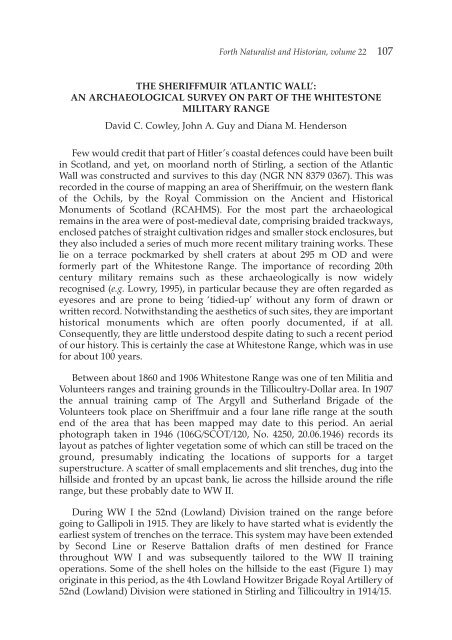the Forth Naturalist Historian - Forth Naturalist and Historian ...
the Forth Naturalist Historian - Forth Naturalist and Historian ...
the Forth Naturalist Historian - Forth Naturalist and Historian ...
You also want an ePaper? Increase the reach of your titles
YUMPU automatically turns print PDFs into web optimized ePapers that Google loves.
<strong>Forth</strong> <strong>Naturalist</strong> <strong>and</strong> <strong>Historian</strong>, volume 22 107<br />
THE SHERIFFMUIR ‘ATLANTIC WALL’:<br />
AN ARCHAEOLOGICAL SURVEY ON PART OF THE WHITESTONE<br />
MILITARY RANGE<br />
David C. Cowley, John A. Guy <strong>and</strong> Diana M. Henderson<br />
Few would credit that part of Hitler’s coastal defences could have been built<br />
in Scotl<strong>and</strong>, <strong>and</strong> yet, on moorl<strong>and</strong> north of Stirling, a section of <strong>the</strong> Atlantic<br />
Wall was constructed <strong>and</strong> survives to this day (NGR NN 8379 0367). This was<br />
recorded in <strong>the</strong> course of mapping an area of Sheriffmuir, on <strong>the</strong> western flank<br />
of <strong>the</strong> Ochils, by <strong>the</strong> Royal Commission on <strong>the</strong> Ancient <strong>and</strong> Historical<br />
Monuments of Scotl<strong>and</strong> (RCAHMS). For <strong>the</strong> most part <strong>the</strong> archaeological<br />
remains in <strong>the</strong> area were of post-medieval date, comprising braided trackways,<br />
enclosed patches of straight cultivation ridges <strong>and</strong> smaller stock enclosures, but<br />
<strong>the</strong>y also included a series of much more recent military training works. These<br />
lie on a terrace pockmarked by shell craters at about 295 m OD <strong>and</strong> were<br />
formerly part of <strong>the</strong> Whitestone Range. The importance of recording 20th<br />
century military remains such as <strong>the</strong>se archaeologically is now widely<br />
recognised (e.g. Lowry, 1995), in particular because <strong>the</strong>y are often regarded as<br />
eyesores <strong>and</strong> are prone to being ‘tidied-up’ without any form of drawn or<br />
written record. Notwithst<strong>and</strong>ing <strong>the</strong> aes<strong>the</strong>tics of such sites, <strong>the</strong>y are important<br />
historical monuments which are often poorly documented, if at all.<br />
Consequently, <strong>the</strong>y are little understood despite dating to such a recent period<br />
of our history. This is certainly <strong>the</strong> case at Whitestone Range, which was in use<br />
for about 100 years.<br />
Between about 1860 <strong>and</strong> 1906 Whitestone Range was one of ten Militia <strong>and</strong><br />
Volunteers ranges <strong>and</strong> training grounds in <strong>the</strong> Tillicoultry-Dollar area. In 1907<br />
<strong>the</strong> annual training camp of The Argyll <strong>and</strong> Su<strong>the</strong>rl<strong>and</strong> Brigade of <strong>the</strong><br />
Volunteers took place on Sheriffmuir <strong>and</strong> a four lane rifle range at <strong>the</strong> south<br />
end of <strong>the</strong> area that has been mapped may date to this period. An aerial<br />
photograph taken in 1946 (106G/SCOT/120, No. 4250, 20.06.1946) records its<br />
layout as patches of lighter vegetation some of which can still be traced on <strong>the</strong><br />
ground, presumably indicating <strong>the</strong> locations of supports for a target<br />
superstructure. A scatter of small emplacements <strong>and</strong> slit trenches, dug into <strong>the</strong><br />
hillside <strong>and</strong> fronted by an upcast bank, lie across <strong>the</strong> hillside around <strong>the</strong> rifle<br />
range, but <strong>the</strong>se probably date to WW II.<br />
During WW I <strong>the</strong> 52nd (Lowl<strong>and</strong>) Division trained on <strong>the</strong> range before<br />
going to Gallipoli in 1915. They are likely to have started what is evidently <strong>the</strong><br />
earliest system of trenches on <strong>the</strong> terrace. This system may have been extended<br />
by Second Line or Reserve Battalion drafts of men destined for France<br />
throughout WW I <strong>and</strong> was subsequently tailored to <strong>the</strong> WW II training<br />
operations. Some of <strong>the</strong> shell holes on <strong>the</strong> hillside to <strong>the</strong> east (Figure 1) may<br />
originate in this period, as <strong>the</strong> 4th Lowl<strong>and</strong> Howitzer Brigade Royal Artillery of<br />
52nd (Lowl<strong>and</strong>) Division were stationed in Stirling <strong>and</strong> Tillicoultry in 1914/15.



